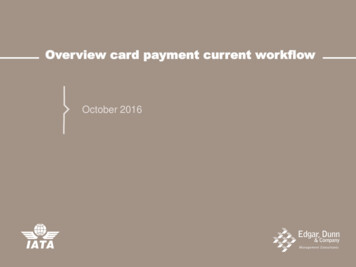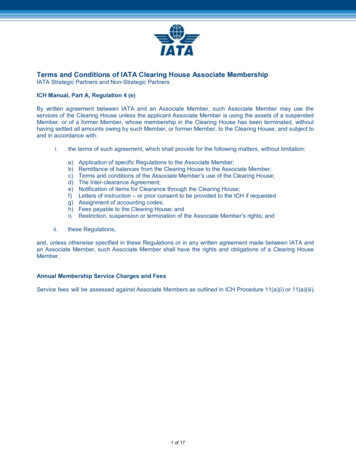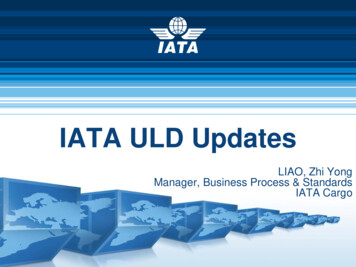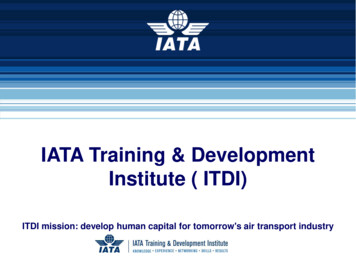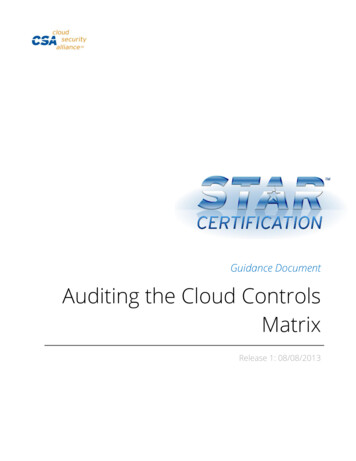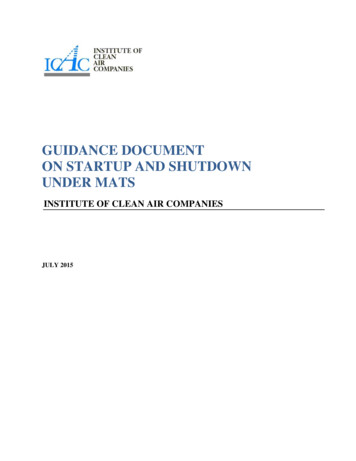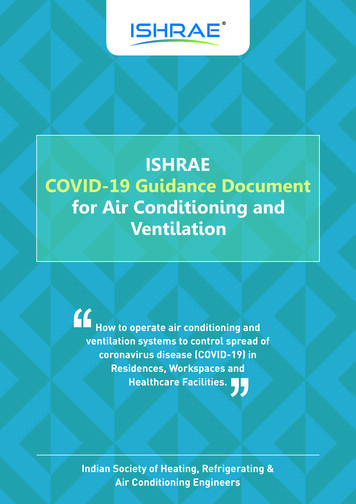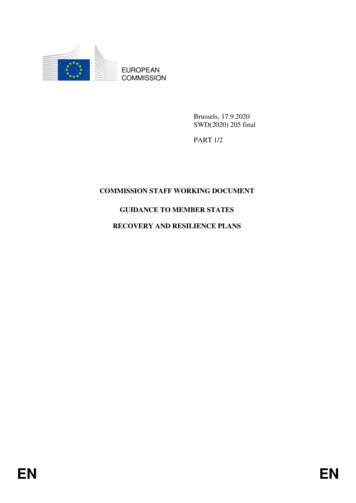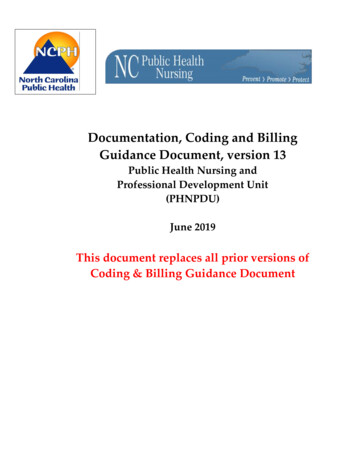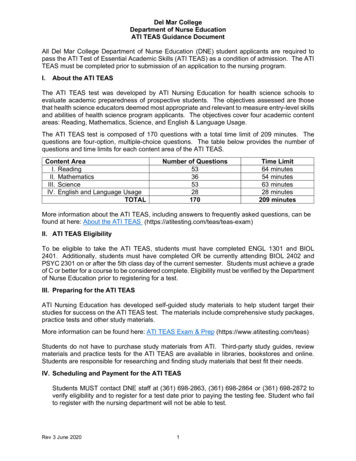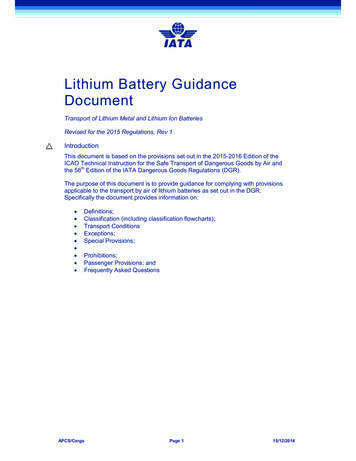
Transcription
Lithium Battery GuidanceDocumentTransport of Lithium Metal and Lithium Ion BatteriesRevised for the 2015 Regulations, Rev 1IntroductionThis document is based on the provisions set out in the 2015-2016 Edition of theICAO Technical Instruction for the Safe Transport of Dangerous Goods by Air andthe 56th Edition of the IATA Dangerous Goods Regulations (DGR).The purpose of this document is to provide guidance for complying with provisionsapplicable to the transport by air of lithium batteries as set out in the DGR.Specifically the document provides information on:xxxxxxxxxDefinitions;Classification (including classification flowcharts);Transport ConditionsExceptions;Special Provisions;Prohibitions;Passenger Provisions; andFrequently Asked QuestionsAPCS/CargoPage 115/12/2014
IATA Lithium Battery Guidance Document - 2014DefinitionsLithium Battery – The term “lithium battery” refers to a family of batteries withdifferent chemistries, comprising many types of cathodes and electrolytes. For thepurposes of the DGR they are separated into:Lithium metal batteries. Are generally primary (non-rechargeable) batteries thathave lithium metal or lithium compounds as an anode. Lithium metal batteries aregenerally used to power devices such as watches, calculators, cameras, temperaturedata loggers.Note:As of 1 January 2015 lithium metal batteries packed by themselves (not contained inor packed with equipment) are forbidden for transport as cargo on passengeraircraft).Figure 1 - Example of Lithium Metal BatteriesLithium-ion batteries (sometimes abbreviated Li-ion batteries) are a type ofsecondary (rechargeable) battery commonly used in consumer electronics. Alsoincluded within the category of lithium-ion batteries are lithium polymer batteries.Lithium-ion batteries are generally found in mobile telephones, laptop computers, etc.Figure 2 - Example of a Lithium Ion BatteryThe technical definition of a battery and cell, as indicated in the UN Manual of Testsand Criteria, is as follows:APCS/CargoPage 215/12/2014
IATA Lithium Battery Guidance Document - 2014“Battery” means two or more cells which are electrically connected together andfitted with devices necessary for use, for example, case, terminals, marking andprotective devices. A single cell lithium battery is considered a "cell" and must betested according to the testing requirements for "cells" for the purposes of theseRegulations and the provisions of subsection 38.3 of the UN Manual of Tests andCriteria (see also the definition for "cell").Note:Units that are commonly referred to as “battery packs”, “modules” or “batteryassemblies” having the primary function of providing a source of power to anotherpiece of equipment are for the purposes of these Regulations and the provisions ofSubsection 38.3 of the UN Manual of Tests and Criteria treated as batteries.“Cell” means a single encased electrochemical unit (one positive and one negativeelectrode) which exhibits a voltage differential across its two terminals. Under theseRegulations and the UN Manual of Tests and Criteria, to the extent the encasedelectrochemical unit meets the definition of “cell” herein, it is a “cell”, not a “battery”,regardless of whether the unit is termed a “battery” or a “single cell battery” outside ofthese Regulations and the UN Manual of Tests and CriteriaButton cell or battery means a round small cell or battery when the overall height isless than the diameter.Classification (DGR 3.9.2.6)Lithium batteries are classified in Class 9 – Miscellaneous dangerous goods as:xxUN 3090, Lithium metal batteries; andUN 3480, Lithium ion batteriesor, if inside a piece of equipment or packed separately with a piece of equipment as:xxUN 3091, Lithium metal batteries contained in equipment; orxUN 3481, Lithium ion batteries contained in equipment; orxUN 3091, Lithium metal batteries packed with equipment; andUN 3481, Lithium ion batteries packed with equipment.In the absence of exceptions, these batteries must be shipped in quantities thatcomply with the limitations contained in the DGR (see DGR Table 4.2 and theapplicable packing instruction). They must be contained in a UN specificationpackaging as prescribed by the applicable packing instruction in the DGR. Acompleted package must display a Class 9 hazard label in addition to markings thatidentify the applicable proper shipping name and UN number. A shipper mustdocument the shipment using a Shipper’s Declaration for Dangerous Goods.Beginning 1 Jan 2013 the classification criteria for lithium batteries stipulates thatcells and batteries must be manufactured under a quality management program.DGR 3.9.2.6 (LBSG 3.3.2) includes the elements that must be included in such aprogram.APCS/CargoPage 315/12/2014
IATA Lithium Battery Guidance Document - 2014Transport ConditionsThe following information is a summary of the conditions that apply to various sizesof batteries for air transport. More details on the exceptions are found in the nextsection of this document.1. Section I / IA Packing Instructions 965 – 970Lithium ion and lithium metal cells and batteries (PI 965 & PI 968, Section IA andPI 966, PI 967, PI 969 & PI 970, Section I) are subject to all of the applicablerequirements in the DGR. These requirements are as follows:(a) dangerous goods training (DGR 1.5);(b) limitations on consolidations (DGR 1.3.3 and 9.1.8);(c) classification (DGR 3.9.2.6);(d) limits on the net quantity of lithium batteries per package (DGR 4.2 andapplicable packing instruction);(e) UN specification packaging (applicable packing instruction, see also DGRSection 6);Note: UN specification packaging does not apply to PI 967 and PI 970.(f) marking and labelling of packages (DGR Section 7)Note: packages must not bear the lithium battery handling label., Packagesmust only bear the Class 9 hazard label and Cargo Aircraft Only label, whenapplicable. If packages are assembled into an overpack the requirements foroverpacks in DGR 7.1.7 and 7.2.7 apply;(g) Shipper’s Declaration for Dangerous Goods (DGR Section 8);2. Section IB - Packing Instructions 965 & 968Lithium ion and lithium metal cells and batteries that meet the Watt-hour or lithiumcontent limits set out in Section II of PI 965 and PI 968 respectively, but thatexceed the weight or quantity limits set out in Table 956-II or Table 968-II aresubject to all of the applicable requirements in the DGR except for therequirements for UN specification packagings.The requirements applicable are as follows:(a) dangerous goods training (DGR 1.5);(b) limitations on consolidations for lithium metal batteries (DGR 1.3.3 and 9.1.8);(c) classification (DGR 3.9.2.6);(d) limits on the total weight per package (applicable packing instruction);(e) strong outer packagings (see Section IB of applicable packing instruction);(f) marking and labelling of packages (DGR Section 7)Note: packages must bear both the lithium battery handling label and theClass 9 hazard label and Cargo Aircraft Only label, when applicable. Ifpackages are assembled into an overpack the requirements for overpacks inDGR 7.1.7 and 7.2.7 apply;(g) Shipper’s Declaration for Dangerous Goods (Section IB of PI 965 or PI 968);Note 1: “IB” must be added to the DGD following the packing instructionnumber. This can be done either with the PI number, e.g. 965 IB, or asAPCS/CargoPage 415/12/2014
IATA Lithium Battery Guidance Document - 2014shown in Dangerous Goods Regulations Figure 8.1.P, in the authorisationscolumn. Refer to Section 8 of the IATA Dangerous Goods Regulations for fulldetails.Note 2: if packages of Section IB are consolidated with other cargo, theprovisions of DGR 1.3.3.3 and 1.3.3.6 apply. If packages are assembled intoan overpack the requirements for overpacks in DGR 8.1.6.9.3, Step 7 apply.3. Section II - Packing Instructions 965 – 970“Small” lithium ion and lithium metal cells and batteries that meet the Watt-hour orlithium content limits set out in Section II of PI 965 to PI 970 are only subject tocertain parts of the DGR when shipped as cargo. The bulk of the requirements forthese small lithium batteries are contained within the General Requirements atthe start of each packing instruction which apply to all lithium batteries and thenthe specific requirements set out in Section II of each packing instruction, whichare as follows:(a) classification (DGR 3.9.2.6);(b) limitations on consolidations for lithium metal batteries in PI968 only (DGR1.3.3 and 9.1.8);(c) limits on the quantity of lithium cells or batteries per package (Table II of theapplicable packing instruction);(d) strong outer packagings (see Section II of applicable packing instruction);(e) marking and labelling of packages (Additional Requirements of Section II ofthe applicable packing instruction);(f) the details of the consignment must be described (Additional Requirements ofSection II of the applicable packing instruction).ExceptionsSmall lithium metal and lithium ion batteries are not subject to all of the provisions ofthe DGR provided that they comply with all of the requirements set out in Section II ofPacking Instructions 965, 966 and 967 for lithium ion batteries and Section II ofPacking Instructions 968, 969 and 970 for lithium metal batteries in the 56th Edition ofthe IATA DGR.Packages containing lithium batteries, or lithium batteries contained in, or packedwith, equipment that meet the provisions of Section II of these packing instructionsare not required to have a Class 9 hazard label and there is no requirement for aShipper’s Declaration for Dangerous Goods for consignments of these batteries.However, in the event of an incident involving these batteries, the incident reportingrequirements apply.Note:Only batteries that have successfully passed the test procedures of Part III, SubSection 38.3 of the UN Manual of Tests and Criteria qualify under this exception. Thisis also true for so-called “OEM” or “aftermarket” batteries. Any battery manufactureror distributor should be able to provide documentation confirming that the batterieshave been so tested.Quantities of lithium metal and lithium ion cells and batteries that exceed the “perpackage” limits described in Section II of the packing instruction 965 (Table 965-II)and 968 (Table 968-II) must be assigned to class 9 and shipped as “Section IB”. AllAPCS/CargoPage 515/12/2014
IATA Lithium Battery Guidance Document - 2014applicable requirements contained in the IATA Dangerous Goods Regulationsrelating to these commodities must be complied with, including the trainingrequirements, except that UN Specification packaging is not required.Packages must bear the Class 9 hazard label in addition to the lithium batteryhandling label.Lithium metal and lithium ion batteries larger than those permitted by Section II of theapplicable packing instruction must be assigned to Class 9 and consigned asUN 3090 (Lithium metal batteries), UN 3480 (Lithium ion batteries), UN 3091 (Lithiummetal batteries contained in equipment or Lithium metal batteries packed withequipment) or UN 3481 (Lithium ion batteries contained in equipment or Lithium ionbatteries packed with equipment). All applicable requirements contained in the IATADangerous Goods Regulations relating to these commodities must be complied with,including the training requirements; a “Shipper’s Declaration for Dangerous Goods”must be issued, and packages must bear the Class 9 hazard label.Special ProvisionsThere are a number of special provisions which may allow for the transport of lithiumbatteries other than in accordance with the defined conditions or limits, or whichrequire the shipper to take additional precautions when preparing batteries fortransport. The special provisions applicable to lithium batteries are set out following.Notwithstanding the general requirement that prior to being transported each type oflithium battery must have successfully passed the UN test requirements, there isprovision for prototype lithium batteries that have not yet passed the UN testrequirements to be shipped for testing purposes, this testing includes pre-productionor product compatibility testing, in accordance with Special Provision A88, as follows:A88 Prototype or low production, (i.e. annual production runs consisting of nomore than 100 lithium cells or batteries) lithium cells or batteries that have notbeen tested to the requirements in subsection 38.3 of the UN Manual of Testsand Criteria may be transported aboard cargo aircraft, if approved by theappropriate authority of the State of origin and the following requirements aremet:a) except as provided in paragraph (c), the cells or batteries must betransported in an outer packaging that is a metal, plastic or plywood drumor a metal, plastic or wooden box and that meets the criteria for PackingGroup I packagings;b) except as provided in paragraph (c), each cell or battery must beindividually packed in an inner packaging inside an outer packaging andsurrounded by cushioning material that is non-combustible, and nonconductive. Cells or batteries must be protected against short-circuiting;c) lithium batteries with a mass of 12 kg or greater and having a strong,impact resistant outer casing, or assemblies of such batteries, may bepacked in strong outer packagings or protective enclosures not subject tothe requirements of Section 6 of these Regulations. The batteries orbattery assemblies must be protected against short circuiting; andd) a copy of the document of approval showing the quantity limitations mustaccompany the consignment.APCS/CargoPage 615/12/2014
IATA Lithium Battery Guidance Document - 2014Irrespective of the limit specified in Column L of Table 4.2, the battery orbattery assembly as prepared for transport may have a mass exceeding35 kg.For air transport, specific quantity limits apply to the net weight of lithium batteries ina package. The maximum net weight of lithium batteries per package for CargoAircraft Only is 35 kg. However, there is provision for large lithium batteries that havea net weight exceeding 35 kg to be consigned on a cargo aircraft in accordance withSpecial Provision A99 as follows:A99 Irrespective of the per package quantity limit for cargo aircraft specified inColumn L of the List of Dangerous Goods (Subsection 4.2), and in Section I ofPacking Instructions 965, 966, 967, 968, 969 or 970, a lithium battery orbattery assembly (UN 3090 or UN 3480), including when packed with, orcontained in equipment (UN 3091 or UN 3481) that meets the otherrequirements of Section I of the applicable packing instruction may have amass exceeding 35 kg, if approved by the appropriate authority of the State oforigin. A copy of the document of approval must accompany the consignment.There will be occasion where a manufacturer may wish to have a defective batteryreturned for analysis. However, where such batteries may pose a safety risk they areprohibited from transport by air as set in Special Provision A154, as follows:A154 Lithium batteries identified by the manufacturer as being defective forsafety reasons, or that have been damaged, that have the potential ofproducing a dangerous evolution of heat, fire or short circuit are forbidden fortransport (e.g. those being returned to the manufacturer for safety reasons).One of the major risks associated with the transport of batteries and battery-poweredequipment is short-circuit of the battery as a result of the battery terminals cominginto contact with other batteries or metal objects. Special Provision A164 requiresthat all batteries and battery-powered equipment must be packed to prevent shortcircuit an inadvertent operation as follows:A164 Any electrical battery or battery-powered device, equipment of vehiclehaving the potential of a dangerous evolution of heat must be prepared fortransport so as to prevent:(a) a short circuit (e.g. in the case of batteries by the effective insulation ofexposed terminals; or in the case of equipment, by disconnection of thebattery and protection of exposed terminals); and(b) unintentional activation.When a shipment of a combination of lithium batteries contained in equipment andlithium batteries packed with equipment is presented for transport, the classificationis to be lithium batteries packed with equipment as indicated by special provisionA181.A181 When a package contains a combination of lithium batteries containedin equipment and lithium batteries packed with equipment, the package mustbe marked UN 3091 Lithium metal batteries packed with equipment, or UN3481 Lithium ion batteries packed with equipment as appropriate. If apackage contains both lithium ion batteries and lithium metal batteries, thepackage must be marked as required for both battery types. However, buttoncell batteries installed in equipment (including circuit boards) need not beconsidered.APCS/CargoPage 715/12/2014
IATA Lithium Battery Guidance Document - 2014Questions have been asked regarding whether to classify equipment with lithiumbatteries as battery-powered equipment, or only lithium batteries contained inequipment. Special Provision A182 makes it clear that the requirement is to use thelithium battery specific entries when only those batteries are present.A182 Equipment containing only lithium batteries must be classified as eitherUN 3091 or UN 3481.It has been clarified that waste batteries are not permitted in air transport with theaddition of Special Provision A183.A183 Waste batteries and batteries being shipped for recycling or disposal areprohibited from air transport unless approved by the appropriate nationalauthority of the State of Origin and the State of the Operator.Questions have been asked regarding whether to classify vehicles powered only bylithium batteries as vehicles, or using a lithium battery entry. Special Provision A185makes it clear that the requirement is to use the battery-powered vehicle entry.A185 Vehicles only powered by lithium metal batteries or lithium ion batteriesmust be consigned under the entry UN 3171, Battery-powered vehicleEffective 1 January 2015 lithium metal batteries by themselves (UN 3090) areprohibited on passenger aircraft. An exemption may be granted by the Statesconcerned in accordance with Special Provision A201:A201 States concerned may grant an exemption from the prohibition to transportlithium metal batteries as cargo on passenger aircraft in accordance with 1.2.6.Authorities issuing exemptions in accordance with this special provision must providea copy to the Chief of the Cargo Safety Section within three months of issuance viaemail at: CSS@icao.int, via facsimile at 1 514-954-6077 or via post to the followingaddress:Chief, Cargo Safety SectionInternational Civil Aviation Organization999 University StreetMontreal, QuebecCANADA H3C 5H7Classification FlowchartsThe following (2) classification flowcharts are intended to provide guidance onthe classification for lithium metal and lithium ion batteries.APCS/CargoPage 815/12/2014
Classification Flowchart – Lithium Ion BatteriesAll cells and batteries must be tested in accordance withthe UN Manual of Tests and Criteria Part III Subsection38.3 (DGR 3.9.2.6)NoPassedUN?RedesignYesLithium IonBatteriesLithium IonBatteriesContained inEquipmentCells greater than20 Wh; andBatteries greaterthan 100 WhUN3481PI 967Section IIMP: RLICells equal to orless than 20 Wh;andBatteries equal toor less than 100 WhUN3481PI 967Section IIIMP: ELILimit per package:Pax A/C 5 kgCAO 35 kgLimit per package:Pax A/C 5 kgCAO 5 kgAPCS/CargoCells greater than20 Wh; andBatteries greaterthan 100 WhUN3480PI 965Section IAIMP: RLILimit per package:Pax A/C 5 kgCAO 35 kgCells equal to or lessthan 20 Wh; andBatteries equal to orless than 100 WhCells equal to or lessthan 20 Wh; andBatteries equal to orless than 100 WhUN3480PI 965Section IBIMP: RLIUN3480PI: 965Section IIIMP: ELINOTE: Use “IB” ifpackage exceedsSection II LimitsLimit per package:Pax A/C 10 kg CAO 10 kgPage 9Lithium IonBatteries PackedWith EquipmentL
Revised for the 2015 Regulations, Rev 1 Introduction This document is based on the provisions set out in the 2015-2016 Edition of the ICAO Technical Instruction for the Safe Transport of Dangerous Goods by Air and the 56th Edition of the IATA Dangerous Goods Regulations (DGR).File Size: 591KB
